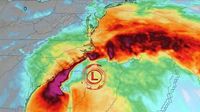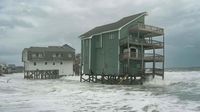As the calendar flipped to mid-October 2025, the U.S. East Coast found itself bracing for a formidable weather event—a nameless Nor’easter, churning up the Atlantic and threatening millions from Florida to New England. Unlike the hurricanes that often dominate headlines with dramatic names and relentless coverage, this storm arrived with little fanfare in terms of nomenclature, but its impact was anything but subtle.
According to ABC News, the system began developing off the Florida coast and was forecast to track northward over the weekend, with direct impacts expected from the Carolinas up to New England. The National Weather Service and AccuWeather meteorologists warned that the storm would bring at least 1 to 3 inches of rain and wind gusts between 20 and 40 mph to inland areas, while coastal regions could see up to 4 to 5 inches of rain and gusts reaching 50 to 60 mph. Coastal flooding, significant beach erosion, and heavy surf were all on the menu for communities along the Atlantic shoreline.
By late on October 10, as reported by the Associated Press, the Southeast Coast from Florida up to Wilmington, Delaware, was already experiencing heavy rain, with some downpours intense enough to cause flash flooding. In Charleston, South Carolina, seawater surged into the city, closing about three dozen roads as floodwaters reached well above ankles before receding. Friday morning’s high tide at Charleston Harbor reached 8.46 feet—remarkably, the 13th highest in more than a century of recorded data. Tidal flooding also temporarily closed roads along the coasts of Georgia and Florida.
Charleston wasn’t alone in its struggles. High king tides, coinciding with the moon’s closest approach to Earth, amplified the threat. The persistent, strong winds and surging seas battered the North Carolina Outer Banks, where, as the AP noted, a series of storms over the past month had already destroyed 10 houses and breached protective dunes. In Buxton, some homes’ pilings were already in the waves before the storm’s peak even arrived. Officials warned that highway N.C. 12 on Hatteras and Ocracoke islands would likely close again due to ocean overwash—a familiar headache for residents of these vulnerable barrier islands.
The threat was only expected to intensify and shift northward through the weekend and into the Columbus Day holiday on Monday, October 13. The worst conditions, forecasters said, would spread from the Carolinas up the coast, with the Mid-Atlantic and Northeast bracing for major impacts. Coastal Flood Alerts and High Surf Alerts were in effect from Miami all the way to New England, and moderate to major coastal flooding was forecast from Norfolk, Virginia, up to Long Island, New York. Some communities faced the prospect of structural damage, especially in low-lying coastal and bayside neighborhoods.
AccuWeather meteorologists described the storm as potentially evolving into a subtropical or hybrid system, with the next available name on the 2025 Atlantic list being Lorenzo. Whether it would reach that threshold or not, the impacts would be severe. "This will be a damaging and disruptive storm along the Atlantic coast," said AccuWeather Chief On-Air Meteorologist Bernie Rayno. Winds were expected to reach sustained speeds of 20 to 30 mph, with gusts up to 60 mph in places like southern Delaware, coastal New Jersey, and Long Island. Wind Advisories were also issued for the Outer Banks and Cape Cod Peninsula, where gusts could hit 45 to 50 mph.
Travelers were warned to expect significant disruptions. High winds could impact flights at major airports in New York City, Boston, and Philadelphia, potentially leading to delays and cancellations. Outdoor events and plans across the Mid-Atlantic and southern New England were likely to be upended by expanding rainfall and increasing winds. AccuWeather’s Dave Dombek cautioned, "High winds may impact flights along the coast and lead to airline delays and flight cancellations."
The storm’s power wasn’t limited to wind and rain. The combination of strong onshore winds and high tides was expected to push seawater into back bays and estuaries, creating a broad zone of storm surge from the Carolinas to southeastern New England. Most areas could see surges of 1 to 3 feet, but some beach communities and back bays faced the risk of 4 to 5 feet—levels not seen since the infamous Superstorm Sandy in 2012 for some locations. AccuWeather’s Local StormMax surge prediction was 6 feet, enough to make some roads impassable, inundate first floors of homes, and damage vehicles parked in low-lying areas. Low tide levels during the storm’s height were forecast to be above normal high tides, further exacerbating the risk.
Offshore, seas were predicted to reach 25 feet—about the height of a three-story building—posing dangers for small craft and even threatening larger vessels. Dangerous surf conditions, frequent and strong rip currents, and large breakers would stretch from the Carolinas to New England, with moderate to major beach erosion expected. Ferry operations and high bridges could be temporarily shut down for safety reasons.
The rainfall forecast was equally daunting. From coastal South Carolina to southern New England, 1 to 4 inches of rain was expected, with localized totals potentially reaching 10 inches, especially from the North Carolina coast to the New Jersey coast. The risk of urban flooding was high, particularly if the storm stalled or looped inland before heading out to sea, overwhelming storm drains and inundating city streets.
While the Nor’easter was non-tropical in nature, the Atlantic and Pacific basins were busy with other storms. Tropical Storm Jerry, for instance, was pulling away from the northern Leeward Islands on Friday, but not before dumping up to 8 inches of rain on Guadeloupe, Antigua and Barbuda, and Saint Maarten—enough to close government offices and schools. In Guadeloupe, authorities reported rescues and one fatality after a car was swept away by floodwaters. "Pointe-à-Pitre is badly affected and is struggling to drain this water. Many places are flooded," said Thierry Devimeux, the island’s government leader, to Guadeloupe La 1ère radio. Meanwhile, in the Pacific, Tropical Storm Raymond threatened coastal Mexico and Baja California Sur, prompting warnings and swelling rivers as far inland as Arizona and New Mexico.
Back on the U.S. East Coast, the storm’s impacts were not limited to immediate flooding and wind damage. Beach erosion, already a chronic problem in many communities, threatened to worsen significantly. The Outer Banks, already battered by a month of relentless storms, faced further dune breaches and property loss. For those living along the Atlantic, this October Nor’easter—named or not—served as a stark reminder of the region’s vulnerability to the whims of ocean and sky.
As the storm continued its trek up the coast, residents, officials, and emergency crews worked to prepare for the worst, hoping that the forecasts would overstate rather than understate the danger. Whether it ultimately earned a name or not, the Nor’easter of October 2025 was certain to leave its mark on the East Coast.

